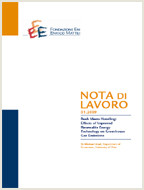Residential Consumption of Gas and Electricity in the U.S.: The Role of Prices and Income

01.01.2011
Anna Alberini, Will Gans, Daniel Velez-Lopez
Q4, Q41, Q48, Q54, Q58
Residential Electricity and Gas Demand, Price Elasticity Of Energy Demand, Static Model, Dynamic Panel Data Model, Partial Adjustment Model
Energy: Resources and Markets
Carlo Carraro
We study residential demand for electricity and gas, working with nationwide household-level data that cover recent years, namely 1997-2007. Our dataset is a mixed panel/multi-year cross-sections of dwellings/households in the 50 largest metropolitan areas in the United States as of 2008. To our knowledge, this is the most comprehensive set of data for examining household residential energy usage at the national level, containing the broadest geographical coverage, and with the longest longitudinal component (up to 6 observations per dwelling). We estimate static and dynamic models of electricity and gas demand. We find strong household response to energy prices, both in the short and long term. From the static models, we get estimates of the own price elasticity of electricity demand in the -0.860 to -0.667 range, while the own price elasticity of gas demand is -0.693 to -0.566. These results are robust to a variety of checks. Contrary to earlier literature (Metcalf and Hassett, 1999; Reiss and White, 2005), we find no evidence of significantly different elasticities across households with electric and gas heat. The price elasticity of electricity demand declines with income, but the magnitude of this effect is small. These results are in sharp contrast to much of the literature on residential energy consumption in the United States, and with the figures used in current government agency practice. Our results suggest that there might be greater potential for policies which affect energy price than may have been previously appreciated.
***
Suggested citation: Anna Alberini, Will Gans, Daniel Velez-Lopez, Residential consumption of gas and electricity in the U.S.: The role of prices and income, Energy Economics, Volume 33, Issue 5, September 2011, Pages 870-881, ISSN 0140-9883, http://dx.doi.org/10.1016/j.eneco.2011.01.015
